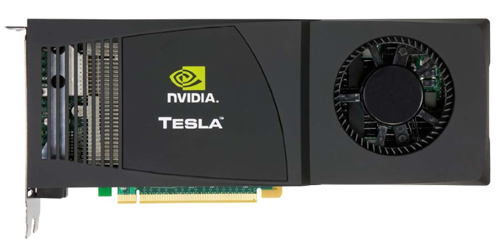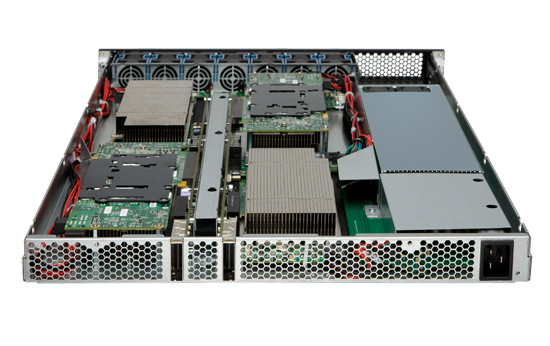NVIDIA's Fermi: Architected for Tesla, 3 Billion Transistors in 2010
by Anand Lal Shimpi on September 30, 2009 12:00 AM EST- Posted in
- GPUs
A Different Sort of Launch
Fermi will support DirectX 11 and NVIDIA believes it'll be faster than the Radeon HD 5870 in 3D games. With 3 billion transistors, it had better be. But that's the extent of what NVIDIA is willing to talk about with regards to Fermi as a gaming GPU. Sorry folks, today's launch is targeted entirely at Tesla.

A GeForce GTX 280 with 4GB of memory is the foundation for the Tesla C1060 cards
Tesla is NVIDIA's High Performance Computing (HPC) business. NVIDIA takes its consumer GPUs, equips them with a ton of memory, and sells them in personal or datacenter supercomputers called Tesla supercomputers or computing clusters. If you have an application that can run well on a GPU, the upside is tremendous.

Four of those C1060 cards in a 1U chassis make the Tesla S1070. PCIe connects the S1070 to the host server.
NVIDIA loves to cite examples of where algorithms ported to GPUs work so much better than CPUs. One such example is a seismic processing application that HESS found ran very well on NVIDIA GPUs. It migrated a cluster of 2000 servers to 32 Tesla S1070s, bringing total costs down from $8M to $400K, and total power from 1200kW down to 45kW.
| HESS Seismic Processing Example | Tesla | CPU |
| Performance | 1 | 1 |
| # of Machines | 32 Tesla S1070s | 2000 x86 servers |
| Total Cost | ~$400K | ~$8M |
| Total Power | 45kW | 1200kW |
Obviously this doesn't include the servers needed to drive the Teslas, but presumably that's not a significant cost. Either way the potential is there, it's just a matter of how many similar applications exist in the world.
According to NVIDIA, there are many more cases like this in the market. The table below shows what NVIDIA believes is the total available market in the next 18 months for these various HPC segments:
| Processor | Seismic | Supercomputing | Universities | Defence | Finance |
| GPU TAM | $300M | $200M | $150M | $250M | $230M |
These figures were calculated by looking at the algorithms used in each segment, the number of Hess-like Tesla installations that can be done, and the current budget for non-GPU based computing in those markets. If NVIDIA met its goals here, the Tesla business could be bigger than the GeForce one. There's just one problem:
As you'll soon see, many of the architectural features of Fermi are targeted specifically for Tesla markets. The same could be said about GT200, albeit to a lesser degree. Yet Tesla accounted for less than 1.3% of NVIDIA's total revenue last quarter.
Given these numbers it looks like NVIDIA is building GPUs for a world that doesn't exist. NVIDIA doesn't agree.
The Evolution of GPU Computing
When matched with the right algorithms and programming efforts, GPU computing can provide some real speedups. Much of Fermi's architecture is designed to improve performance in these HPC and other GPU compute applications.
Ever since G80, NVIDIA has been on this path to bring GPU computing to reality. I rarely get the opportunity to get a non-marketing answer out of NVIDIA, but in talking to Jonah Alben (VP of GPU Engineering) I had an unusually frank discussion.
From the outside, G80 looks to be a GPU architected for compute. Internally, NVIDIA viewed it as an opportunistic way to enable more general purpose computing on its GPUs. The transition to a unified shader architecture gave NVIDIA the chance to, relatively easily, turn G80 into more than just a GPU. NVIDIA viewed GPU computing as a future strength for the company, so G80 led a dual life. Awesome graphics chip by day, the foundation for CUDA by night.
Remember that G80 was hashed out back in 2002 - 2003. NVIDIA had some ideas of where it wanted to take GPU computing, but it wasn't until G80 hit that customers started providing feedback that ultimately shaped the way GT200 and Fermi turned out.
One key example was support for double precision floating point. The feature wasn't added until GT200 and even then, it was only added based on computing customer feedback from G80. Fermi kicks double precision performance up another notch as it now executes FP64 ops at half of its FP32 rate (more on this later).
While G80 and GT200 were still primarily graphics chips, NVIDIA views Fermi as a processor that makes compute just as serious as graphics. NVIDIA believes it's on a different course, at least for the short term, than AMD. And you'll see this in many of the architectural features of Fermi.










415 Comments
View All Comments
SiliconDoc - Thursday, October 1, 2009 - link
Jeezus, you're just that bright, aren't you.The article is dated September 19th, and "they scored a picture" from another website, that "scored a picture".
Our friendly reviewer herer at AT had the cards in his hands, on the bench, IRL.
--
I mean you have like no clue at all, don't you.
palladium - Thursday, October 1, 2009 - link
I agree. GPGPU has come a long way, but it's still in its infancy, at least in the consumer space (Badaboom and AVIVO both had bugs).I just want a card that can play Crysis all very high 19x12 4xAA @60fps. Maybe a dual-GPU GT300 can deliver that.
wumpus - Wednesday, September 30, 2009 - link
First first reaction after reading that the cost of double multiply would be twice that of a single was "great. Half the transistors will be sitting there idle during games." Sure, this isn't meant to be a toy, but it looks like they have given up the desktop graphics to AMD (and whenever Intel gets something working). Maybe they will get volume up enough to lower the price, but there are only so many chips TMSC can make that size.On second thought, those little green squares can't take up half the chip. Any guess what part of the squares are multiplies? Is the cost of fast double point something like 10% of the transistors idle during single (games)? On the gripping hand, makes the claim that "All of the processing done at the core level is now to IEEE spec. That’s IEEE-754 2008 for floating point math (same as RV870/5870)". If they seriously mean that they are prepared to include all rounding, all exceptions, and all the ugly, hairy corner cases that inhabit IEEE-754, wait for Juniper. I really mean it. If you are doing real numerical computing you need IEEE-754. If you don't (like you just want a real framerate from Crysis for once) avoid it like the plague.
Sorry about the rant. Came for the beef on doubles, but noticed that quote when checking the article. Looks like we'll need some real information about what "core level at IEEE-754" means on different processors. Who provides all the rounding modes, and what parts get emulated slowly? [side note. Is anybody with a 5870 able to test underflow in OpenCL? You might find out a huge amount about your chip with a single test].
SiliconDoc - Wednesday, September 30, 2009 - link
I think I'll stick with the giant profitables greens proven track record, not your e-weened redspliferous dissing.Did you watch the NV live webcast @ 1pm EST ?
---
Nvidia is the only gpu company with OBE BILLION DOLLARS PER YEAR IN R&D.
---
That's correct, nvidia put into research on the Geforce, the whoile BILLION ati loses selling their crappy cheap hot cores on weaker thinner pcb with near zero extra features only good for very high rez, which DOESN'T MATCH the cheapo budget pinching purchasrs who buy red to save 5-10 bang for bucks...--
--
Now about that marketing scheme ?
LOL
Ati plays to high rez wins, but has the cheapo card, expecting $2,000 monitor owners to pinch pennies.
"great marketing" ati...
LOL
PorscheRacer - Wednesday, September 30, 2009 - link
Just so you know, ATI is a seperate division in AMD (the graphics side obviously) and did post earnings this year. ATI is keeping the CPU side of AMD afloat in all intents and purposes. Is there a way to ban or block you? I was excited to read about the GF300 and expecting some good comments and discussion about this, and then you wrecked the experience. Now I just don't care.Adul - Thursday, October 1, 2009 - link
silicon idiot is doing more harm than good. please ban himSiliconDoc - Thursday, October 1, 2009 - link
The truth is a good thing, even if you're so used to lies that you don't like it.I guess it's good too, that so many people have tried so hard to think of a rebuttal to any or of all my points, and they don't have one, yet.
Isn't that wonderful ! You fit that category, too.
SiliconDoc - Wednesday, September 30, 2009 - link
Do you think yhour LIES will pass with no backup ?" A.M.D. has struggled for two years to return to profitability, losing billions of dollars in the process.
A.M.D., the No. 2 maker of computer microprocessors after Intel, lost $330 million, or 49 cents a share, in the second quarter. In the same period last year, it lost $1.2 billion, or $1.97 a share.
Excluding one-time gains, A.M.D. says its loss was 62 cents a share. On that basis, analysts had predicted a loss of 47 cents a share, according to Thomson Reuters. Sales fell to $1.18 billion, down 13 percent. Analysts were expecting $1.13 billion."
---
http://www.nytimes.com/2009/07/22/technology/compa...">http://www.nytimes.com/2009/07/22/technology/compa...
ATI card sales did increase a bit, but LOST MONEY anyway. More than expected.
--
PS I'm not sorry I've ruined your fantasy and expsoed your lie. If you keep lying, should you be banned for it ?
PorscheRacer - Thursday, October 1, 2009 - link
http://arstechnica.com/hardware/news/2009/07/intel...">http://arstechnica.com/hardware/news/20...-graphic...Again, the graphics group of AMD turned a profit (albeit a small one after R&D and costs) while the other divisions lost money.
SiliconDoc - Thursday, October 1, 2009 - link
LOL- YOU'VE SIMPLY LIED AGAIN, AND PROVIDED A LINK, THAT CONFIRMS YOU LIED.It must be tough being such a slumbag.
--
" After the channel stopped ordering GPUs and depleted inventory in anticipation of a long drawn out worldwide recession in Q3 and Q4 of 2008, expectations were hopeful, if not high that Q1’09 would change for the better. In fact, Q1 showed improvement but it was less than expected, or hoped. Instead, Q2 was a very good quarter for vendors – counter to normal seasonality – but then these are hardly normal times.
Things probably aren't going to get back to the normal seasonality till Q3 or Q4 this year, and we won't hit the levels of 2008 until 2010."
As you should have a clue, noting, 2008 was bad, and they can't even reach that pathetic crash until 2010.
An increase in sales from a recent prior full on disaster decrease, is still less than the past, is low in the present, and is " A LOSS " PERIOD.
You don't provide text because NOTHING at your link claims what you've said, you are simply a big fat LIAR.
Thanks for the link anyway, that links my link:
http://jonpeddie.com/press-releases/details/amd-so...">http://jonpeddie.com/press-releases/det...ntel-and...
This is a great quote: " We still believe there will be an impact from the stimulus programs worldwide "
LOL
hahahhha - just as I kept supposing.
" -Jon Peddie Research (JPR), the industry's research and consulting firm for graphics and multimedia"
---
NOTHING, AT either link, describes a profit for ati graphics, PERIOD.
Try again mr liar.